This is topic Baseline Dyno Numbers -> Stock 96 Cobra in forum Tech Talk at Northern California Ford Owners .
To visit this topic, use this URL:
https://californiafords.com/cgi-bin/ultimatebb.cgi?ubb=get_topic;f=6;t=022464
Posted by Luke87GT (Member # 21) on
:
Hi folks,
I was finally able to get some baseline dyno numbers on my 96 Cobra this weekend. Before I go any further, the only mods worth mentioning at this point are the FMS aluminum driveshaft and the FMS 4.30 gears. I don’t think there is anything else on the car currently that would influence power figures in any significant way.
Some additional information… The spark plugs and wires have about 15K miles and the fuel filter is brand new. With 89 octane in the tank and 82deg air temperature, the car laid down 271.13rwhp@5750rpm & 263.64rwtq@4550rpm uncorrected, however, all the numbers below are shown as SAE corrected with “level-5” smoothing. We performed four baselines runs with approximately 10-15 minutes of cool down between each pull with a large fan blowing over the motor.
The A/F was measured out the tailpipe. Since I am still running stock cats, and since the measurements were taken far downstream of the motor, I was told by the tuner that the meter would read leaner than it really is.
Run #1
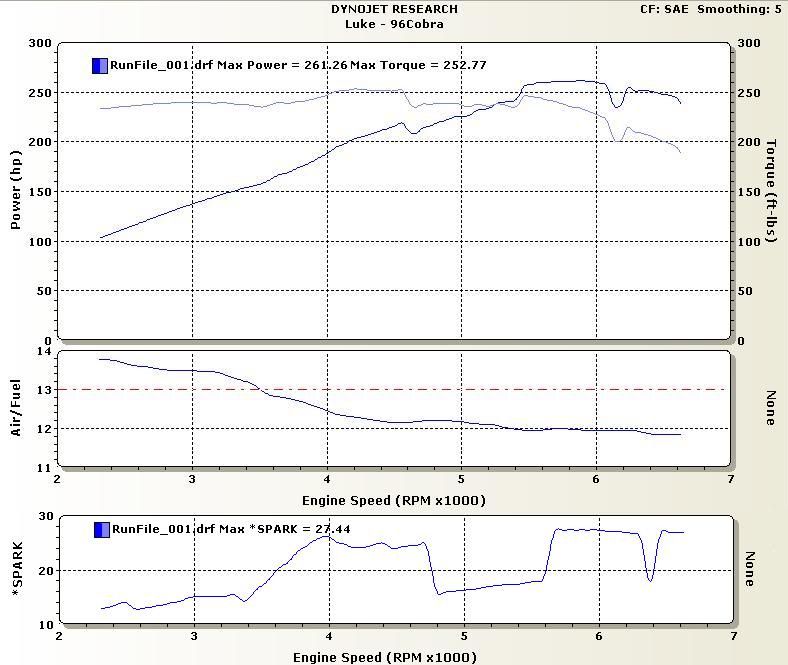
The car laid down 261rwhp/253rwtq SAE, however, there were two small dips within the power curve that were each briefly responsible for about ~10rwhp loss looking at the peak-to-peak results. After studying the OBDII log parameters, I discovered that the only data log that stood out was the spark advance, which is shown above. The dips in power seem to roughly coincide with the dips in the spark (am I correct to assume that this data-log parameter is simply the timing? In other words the motor was briefly pulling timing during this run? If so, what could potentially cause that?). You can see that the spark is at about 25 degrees and then drops down to 18 degrees.
Run #2

The car laid down 268rwhp/261rwtq SAE. Once again, the dips in power coincide with the dips in spark advance… 27deg down to 18 degrees this time.
Run #3
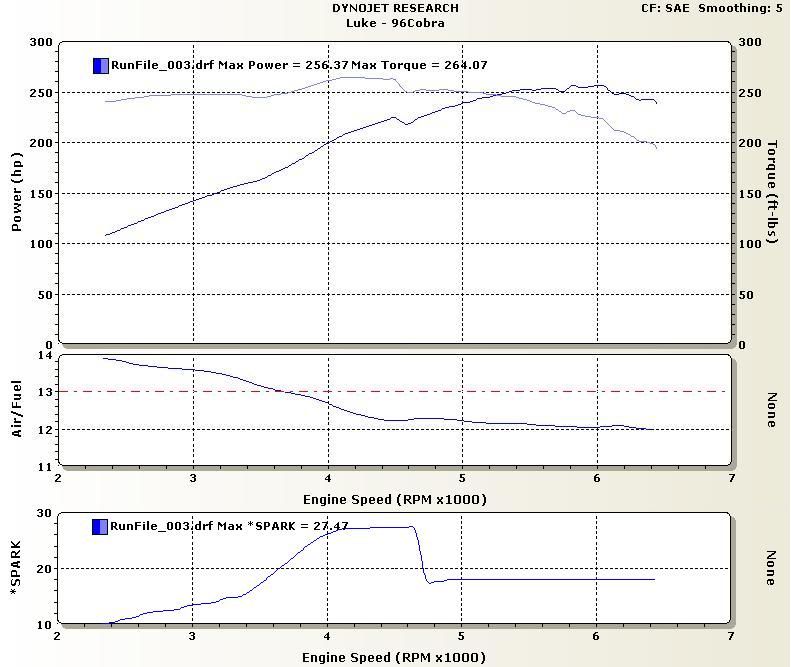
The car laid down 256rwhp/264rwtq SAE. As you can see, at about 4700rpm, the spark dropped from 27deg down to 18deg and stayed flat all the way through the pull resulting in about 12rwhp short of the previous pull!
In order to isolate the spark from the IMRC plates, we decided to do one more pull and monitor the voltage output of the IMRCs to ensure that they are staying open at high RPM.
Run #4
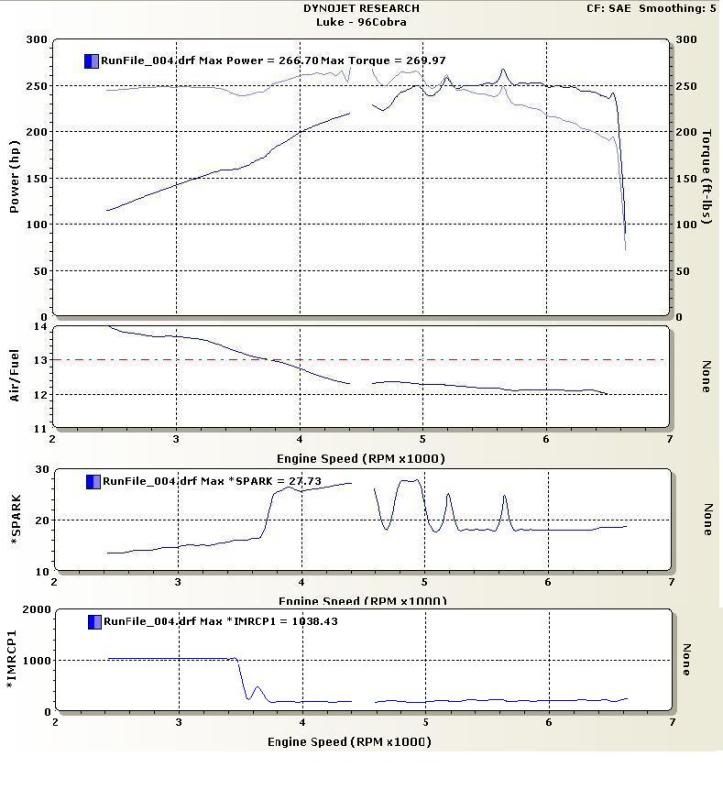
The car laid down 267rwhp/270rwtq SAE this time. As you can see from the graph, the car made peak HP during a short pulse transition where the spark jumped from 18deg to 25deg briefly. The IMRC show to be opening at 3600rpm and don’t look to be influencing anything negatively.
One conclusion is that the car seems to be running far too rich according to the A/F data. Also, the remaining question I have now is what could be influencing the spark to drop from 25-27deg to 17-18deg at high RPM (this looks to be costing me ~10rwhp). It was certainly a warm day, and the car did not have much time to cool. The 89 octane probably didn’t help either.
Also, I will do my research, but if anyone could shed some light on more information about the “Spark” data log parameter, what exactly it is, and what influences it, I’d appreciate it! The following items were logged in case any of them may give us an additional clue (I'd be happy to post any available data here):

Next time I dyno, the car will have new ignition coils, 91 octane in the tank, JLT intake, exhaust, pulleys, IMRC deletes and a short runner…
The tuner recommended that I check the plugs, the resistance of the plug wires, and consider replacing the stock coils before I go in for a dyno tune.
I look forward to your feedback! ![[patriot]](graemlins/patriot.gif)
Posted by Luke87GT (Member # 21) on
:
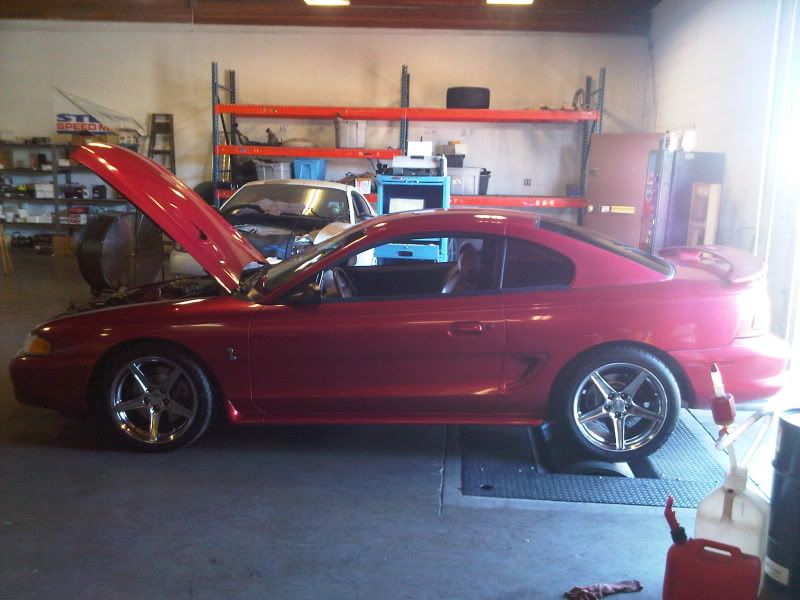
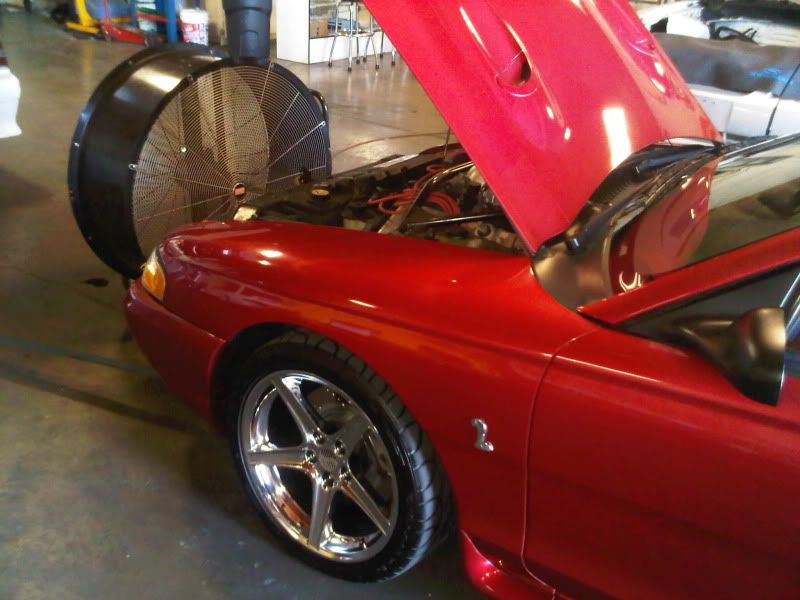
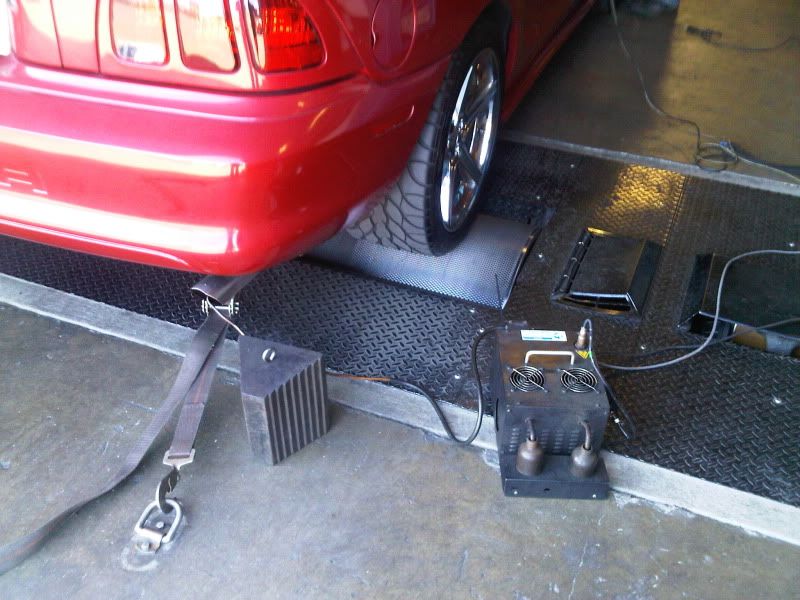
Posted by EPIK (Member # 7481) on
:
Not bad numbers at all Luke. seems to be right on par with what they should normally be given the 305hp rating. 1 question, why are you running 89 octane instead of 91 octane?
Posted by Luke87GT (Member # 21) on
:
Thanks Dustin.
I actually didn't think much of it as the car is bone stock and it is just what I happen to have in there. Looking at the big picture, between the combination of it being hot out (82deg) with limited cool down time, maybe the higher octane would have prevented the spark from jumping around like it did?
89 was probably a mistake on my part...
Posted by SydeWaySix (Member # 3596) on
:
with the mods that you are doing before your next dyno session, what do you expect to make? I'm trying to see what I can do to make 300rwhp without any major mods and still be smog legal. Are you going to run LT's and off-road x/h-pipe?
Posted by LILstock3valve (Member # 4702) on
:
Nice fuckin car
Posted by bottled95GT?? (Member # 1772) on
:
Nice numbers. Is that Nextgen other shop off winton?
Posted by Blind (Member # 3052) on
:
I think the computer was pulling timing because of the knock sensors and the 89 octane, I always run 91 in my 4v, I thought that was the requirement even stock?
Posted by stangin' (Member # 514) on
:
91 octane is roughly about $1-2 more per fill-up. don't skimp on good gas with these motors. it probably did have something to do with the dips.
just for kicks, my old '97 cobra dynoed at 286 rwhp. this was with an o/r x-pipe, cai, pulleys, and catback.
Posted by Luke87GT (Member # 21) on
:
Thanks guys! ![[patriot]](graemlins/patriot.gif)
quote:
Originally posted by SydeWaySix:
with the mods that you are doing before your next dyno session, what do you expect to make? I'm trying to see what I can do to make 300rwhp without any major mods and still be smog legal. Are you going to run LT's and off-road x/h-pipe?
I don't have any firm expectations at this point. I'll try to address the reason why the timing was being pulled and throw the planned mods at it and reaccess...
I will not be running long-tubes, and I have not yet decided on exactly which midpipe will go on but it will have stock manifolds and 2.5" exhaust the rest of the way (straight through mufflers)...
quote:
Originally posted by bottled95GT??:
Nice numbers. Is that Nextgen other shop off winton?
Thanks, yes it is.
quote:
Originally posted by Blind:
I think the computer was pulling timing because of the knock sensors and the 89 octane, I always run 91 in my 4v, I thought that was the requirement even stock?
You might be right Kevin. I should have used 91 octane. If it is detonation, it's puzzling that the A/F ratio was so rich at high RPM. I am sure that 91 octane, 180* stat, and cooler weather would have a positive effect on the timing retard...
quote:
Originally posted by stangin':
just for kicks, my old '97 cobra dynoed at 286 rwhp. this was with an o/r x-pipe, cai, pulleys, and catback.
Nice numbers. If my Cobra lays those numbers before the IMRC deletes/Short runner/Tune, I'd be thrilled...
Cheers! ![[patriot]](graemlins/patriot.gif)
Posted by CobraChick (Member # 9885) on
:
I'm not sure about the older cobra but our 03 cobras says in the manual and on the cluster to use premium fuel. So thats the only thing we put in the car is 91 octane shell or chevron gas only. But like i said might be different with the older one i would look in the manual
Posted by Blind (Member # 3052) on
:
quote:
Originally posted by Luke87GT:
quote:
Originally posted by Blind:
I think the computer was pulling timing because of the knock sensors and the 89 octane, I always run 91 in my 4v, I thought that was the requirement even stock?
You might be right Kevin. I should have used 91 octane. If it is detonation, it's puzzling that the A/F ratio was so rich at high RPM. I am sure that 91 octane, 180* stat, and cooler weather would have a positive effect on the timing retard...
unburned fuel will show as rich at the pipes, so it makes sense for the A/F to appear rich but the engine itself is actually running lean - hook up an SCT and watch the short term fuel trims for each bank during a WOT run to see what the computer is actually doing, when it see's detonation AFAIK it pulls timing and adds fuel.
my fobra made 282rwhp/278rwtq with IMRC delete's, stock mid pipe, BBK fenderwell filter, stock GT MAF, and the dynomax catback, it had an intake manifold vacuum leak from a torn EGR gasket during that, and that's with lincoln cams that everybody says are crap, but I love because the torque curve is just flat ![[Smile]](smile.gif)
I'm looking forward to the next time I dyno it, where I'll be re-tuning it for a lightning MAF, have a new 2.5" midpipe, and fixed the intake manifold leak so the fuel trims don't freak out all over the place now. I'd like to do a short runner also, just hesitant to mess it up, I need to pick up a spare intake to do it to...
[ June 07, 2010, 09:25 PM: Message edited by: Blind ]
Posted by 96mysticman (Member # 8327) on
:
my 96 cobra that i used to have put down 276rwhp/276tq completly bone stock minus an off road xpipe. also it was 98 degrees outside.
maybe if you put the recomended octane in there you might pick up some hp. just my .02
Posted by rozwell911 (Member # 9917) on
:
Luke, are you planning on getting a base tune done when you get the IMRC deletes?
its my understanding that the IMRC delets, when the car is not tuned for them, will cause a loss in low-end torque.
Posted by Luke87GT (Member # 21) on
:
Blind and 96mysticman, those are impressive numbers! What were those figures that you posted? Uncorrected? STD? SAE? And was this untuned? I'm finding that most 96-98 Cobras lay down between 260-270rwhp SAE on a dynojet, stock (There is a lengthy post about this on svtperformance).
It's sometimes frustrating to compare results when people don't specify those figures or even know what they are, lol. If I choose the correct correction and avoid using the smooth function, my numbers are showing 276rwhp.
My preference is that Dynojet would only post SAE to force people to establish a common ground, lol.
[ June 08, 2010, 02:06 PM: Message edited by: Luke87GT ]
Posted by Blind (Member # 3052) on
:
superflow SAE corrected/dynojet comparison #'s, loaded dyno, I didn't get a print out of the raw #'s, but they're not all that different.
my `89 with stock motor 5.0 but all the bolt-on's/no p/s, no smog pump, electric fan, shorty header full exhaust, etc. made 249rwhp/295rwtq on the same dyno, right inline with my buddy coupester/Christian from the corral that made 245rwhp/298rwtq with his bolt on stock motor 5.0 that had longtube exhaust.
[ June 08, 2010, 02:08 PM: Message edited by: Blind ]
Posted by SydeWaySix (Member # 3596) on
:
So how does a Dynojet's numbers compare to a Mustang Dyno's (I think these are the ones where you set the load)?
Posted by Blind (Member # 3052) on
:
quote:
Originally posted by SydeWaySix:
So how does a Dynojet's numbers compare to a Mustang Dyno's (I think these are the ones where you set the load)?
mustang dyno's have really high #'s from what I've seen
Posted by Luke87GT (Member # 21) on
:
quote:
Originally posted by Blind:
quote:
Originally posted by SydeWaySix:
So how does a Dynojet's numbers compare to a Mustang Dyno's (I think these are the ones where you set the load)?
mustang dyno's have really high #'s from what I've seen
Opposite, Mustang Dyno's typically read 5% low
Posted by Luke87GT (Member # 21) on
:
And Blind, you own the highest stock dyno numbers I have ever seen in my life for both a stock 96-98 Cobra and a stock motored 87-93 Mustang with bolt-ons, lol.
![[worship]](graemlins/worship.gif)
Posted by SydeWaySix (Member # 3596) on
:
quote:
Originally posted by Luke87GT:
quote:
Originally posted by Blind:
quote:
Originally posted by SydeWaySix:
So how does a Dynojet's numbers compare to a Mustang Dyno's (I think these are the ones where you set the load)?
mustang dyno's have really high #'s from what I've seen
Opposite, Mustang Dyno's typically read 5% low
Yea, from what I understand they are "more accurate" since they add load to the dyno to resemble the car on the road.
Posted by Blind (Member # 3052) on
:
quote:
Originally posted by SydeWaySix:
quote:
Originally posted by Luke87GT:
quote:
Originally posted by Blind:
quote:
Originally posted by SydeWaySix:
So how does a Dynojet's numbers compare to a Mustang Dyno's (I think these are the ones where you set the load)?
mustang dyno's have really high #'s from what I've seen
Opposite, Mustang Dyno's typically read 5% low
Yea, from what I understand they are "more accurate" since they add load to the dyno to resemble the car on the road.
a lot of dyno's add load
Posted by Luke87GT (Member # 21) on
:
quote:
Originally posted by Blind:
quote:
Originally posted by SydeWaySix:
quote:
Originally posted by Luke87GT:
quote:
Originally posted by Blind:
quote:
Originally posted by SydeWaySix:
So how does a Dynojet's numbers compare to a Mustang Dyno's (I think these are the ones where you set the load)?
mustang dyno's have really high #'s from what I've seen
Opposite, Mustang Dyno's typically read 5% low
Yea, from what I understand they are "more accurate" since they add load to the dyno to resemble the car on the road.
a lot of dyno's add load
Ya, I believe most dynos are loaded dynos. Otherwise the pulls would not take as long as they do.
Posted by 96mysticman (Member # 8327) on
:
quote:
Originally posted by Luke87GT:
Blind and 96mysticman, those are impressive numbers! What were those figures that you posted? Uncorrected? STD? SAE? And was this untuned? I'm finding that most 96-98 Cobras lay down between 260-270rwhp SAE on a dynojet, stock (There is a lengthy post about this on svtperformance).
It's sometimes frustrating to compare results when people don't specify those figures or even know what they are, lol. If I choose the correct correction and avoid using the smooth function, my numbers are showing 276rwhp.
My preference is that Dynojet would only post SAE to force people to establish a common ground, lol.
yeah it was on a dynojet and those are uncorrected numbers. but imo i wouldnt do the imrc deletes mod motors already lack the low end torque why make it any worse? its actually all about what you wanna do? you can either leave the line like an animal with torque or you can be a beast on the top side with the hp.lol have fun ![[Wink]](wink.gif)
Posted by Luke87GT (Member # 21) on
:
The IMRCs cost a few HP below 5K RPM, but it's not anything that can be felt with 4.30s, from what I gather. Above 5K, there is a few HP to be had. It's not the power gains that I am after so much as just not having the butterfly valves in place and risk having them get gunked up or having the IMRC motor stick. Just one less thing to worry about. Since I am going to tune anyway, I don't care about the CEL as it will be eliminated.
Remind me what mods you have to go 114mph (and what uncorrected power level?)
Posted by 96mysticman (Member # 8327) on
:
quote:
Originally posted by Luke87GT:
The IMRCs cost a few HP below 5K RPM, but it's not anything that can be felt with 4.30s, from what I gather. Above 5K, there is a few HP to be had. It's not the power gains that I am after so much as just not having the butterfly valves in place and risk having them get gunked up or having the IMRC motor stick. Just one less thing to worry about. Since I am going to tune anyway, I don't care about the CEL as it will be eliminated.
Remind me what mods you have to go 114mph (and what uncorrected power level?)
yeah thats true if you got that much gear it wouldnt be too bad i suppose.
my cobra had offroad x, 390 gears,aluminum dshaft,detroit locker 31 spline axles, mickeys,spec3 clutch,billet steel flywheel,tko600 trans,75 zex shot. stock suspension, stock motor absolutely nothing on the motor no cai,pulleys nothing. there is a couple people around here that can vouch for that. the uncorrected numbers were 276hp/276tq
Posted by Luke87GT (Member # 21) on
:
Oh, the 114 came with nitrous, gotcha.
Any NA passes?
Posted by 96mysticman (Member # 8327) on
:
the car ran 13.3 n/a yeah i was actually shocked that the car picked up a whole second from the 75 shot. have you timed your car i dont remember reading that?
Posted by 92sleeperGT (Member # 8076) on
:
very good numbers
for a fairly stock cobra ![[patriot]](graemlins/patriot.gif)
Posted by autumnstang97 (Member # 6111) on
:
Damn it...im tempted to get my 98 cobra block and heads back together and stick her back in the GT...im just bein cheap....maybe i'll just pick up a 96-98 Cobra...
Posted by Luke87GT (Member # 21) on
:
quote:
Originally posted by 92sleeperGT:
very good numbers
for a fairly stock cobra ![[patriot]](graemlins/patriot.gif)
Thanks, if the damn thing could hold timing throughout the entire pass, I think 270rwhp SAE could have been very possible.
Nothing some 91 octane, 180* stat, and bigger radiator can't take care of.
Posted by Luke87GT (Member # 21) on
:
quote:
Originally posted by Blind:
quote:
Originally posted by Luke87GT:
quote:
Originally posted by Blind:
I think the computer was pulling timing because of the knock sensors and the 89 octane, I always run 91 in my 4v, I thought that was the requirement even stock?
You might be right Kevin. I should have used 91 octane. If it is detonation, it's puzzling that the A/F ratio was so rich at high RPM. I am sure that 91 octane, 180* stat, and cooler weather would have a positive effect on the timing retard...
unburned fuel will show as rich at the pipes, so it makes sense for the A/F to appear rich but the engine itself is actually running lean - hook up an SCT and watch the short term fuel trims for each bank during a WOT run to see what the computer is actually doing, when it see's detonation AFAIK it pulls timing and adds fuel.
Kevin, you are losing me here...
First, can you define the "short term fuel trim" and explain further what it means? What is teh SCT acronym for this within the data-log?
Also, I am not following how the motor can be running lean if the exhaust is rich, as seen in my dyno graphs?
Thanks
Luke
Posted by Nastysvt (Member # 6431) on
:
114 mph 1/4 mile? I had 4:10s full exhaust(long tubes) c&l intake and 100 shot completely stock motor and ran 12.2 @113 Also your stock coils are fine, you don't need to change them out. Definitely would recommend the 91 octane.
Posted by copcar (Member # 10113) on
:
As a former dyno operator I can shed some light on your situation. I worked at a shop back home for nearly 10 years. I have extensive dyno testing experience.
1) Run 91. It is your knock sensors (you have 2) removing timing. Plain and simple.
2) you are showing power numbers in an uncorrected condition at 82 degrees. As the STD and SAE correction factors are about 3% different and, given your temp at test, your power numbers should show 2% higher in SAE corrected numbers and 5% higher in STD correction... roughly. Unless someone is trying to cheat a number, SAE correction is preferred. Uncorrected numbers are worthless for comparing dyno for dyno comparisons. For that matter a 1% variance is accepted on any dyno.
3) The difference between Eddy Current (Mustang dyno) and Inertia Acceleration (Dynojet) is roughly a 10% margin. Dynojet dynos will always show higher numbers. Mustang Dynos use the simulated load of weight which can be manipulated. It is not uncommon for the curves to differ as well. I would NEVER advise using a Dynojet to tune a combination, only to test the gains/losses of modifications made.
[ July 19, 2010, 04:09 AM: Message edited by: copcar ]
Posted by 03SVTPower (Member # 518) on
:
quote:
Originally posted by copcar:
As a former dyno operator I can shed some light on your situation. I worked at a shop back home for nearly 10 years. I have extensive dyno testing experience.
1) Run 91. It is your knock sensors (you have 2) removing timing. Plain and simple.
2) you are showing power numbers in an uncorrected condition at 82 degrees. As the STD and SAE correction factors are about 3% different and, given your temp at test, your power numbers should show 2% higher in SAE corrected numbers and 5% higher in STD correction... roughly. Unless someone is trying to cheat a number, SAE correction is preferred. Uncorrected numbers are worthless for comparing dyno for dyno comparisons. For that matter a 1% variance is accepted on any dyno.
3) The difference between Eddy Current (Mustang dyno) and Inertia Acceleration (Dynojet) is roughly a 10% margin. Dynojet dynos will always show higher numbers. Mustang Dynos use the simulated load of weight which can be manipulated. It is not uncommon for the curves to differ as well. I would NEVER advise using a Dynojet to tune a combination, only to test the gains/losses of modifications made.
Just find a open road and tune it on the street then go get numbers on a dyno!
![[patriot]](graemlins/patriot.gif)
![[burnout]](graemlins/burnout.gif)
Posted by Blind (Member # 3052) on
:
quote:
Originally posted by Luke87GT:
quote:
Originally posted by Blind:
quote:
Originally posted by Luke87GT:
quote:
Originally posted by Blind:
I think the computer was pulling timing because of the knock sensors and the 89 octane, I always run 91 in my 4v, I thought that was the requirement even stock?
You might be right Kevin. I should have used 91 octane. If it is detonation, it's puzzling that the A/F ratio was so rich at high RPM. I am sure that 91 octane, 180* stat, and cooler weather would have a positive effect on the timing retard...
unburned fuel will show as rich at the pipes, so it makes sense for the A/F to appear rich but the engine itself is actually running lean - hook up an SCT and watch the short term fuel trims for each bank during a WOT run to see what the computer is actually doing, when it see's detonation AFAIK it pulls timing and adds fuel.
Kevin, you are losing me here...
First, can you define the "short term fuel trim" and explain further what it means? What is teh SCT acronym for this within the data-log?
Also, I am not following how the motor can be running lean if the exhaust is rich, as seen in my dyno graphs?
Thanks
Luke
when you have the SCT hooked up to a laptop in the car, you can real time monitor or datalog basically any sensor.
The short term fuel trims I believe are STFT1 and STFT2 for bank 1 and bank 2, these are a realtime view of how the computer is compensating for how the engine is running, it has a range of like -10 to +10, and shows how much fuel is being adjusted.
If the fuel trims aren't around zero, the computer is trying to correct for a problem, either the knock sensors or o2 sensors giving it a bad reading.
if the engine is running lean, or the combustion cycle isn't completing properly, you'll get a rich condition out of the tail pipes, especially if you don't have cats, the unburned fuel will just be read by the a/f sensor.
Posted by Luke87GT (Member # 21) on
:
Hi Kevin,
It looks like my Dynojet run did not log STFT1 and STFT2... It did log SHRTFT1 and SHRTFT2 which range from 0.75-0.86 (not sure on the units). I wish I knew what this were, lol.
Next time I dyno, I'd like to log the STFT1, STFT2, & the knock sensors. Do you know what the dynojet acronym is for the knock sensors?
quote:
Originally posted by BLIND:
if the engine is running lean, or the combustion cycle isn't completing properly, you'll get a rich condition out of the tail pipes, especially if you don't have cats, the unburned fuel will just be read by the a/f sensor.
Not sure I agree here. It's possible that the car can be out of tune and dumping a significant amount of raw unburnt fuel to the exhaust. However, if we assume that the car is in good tune, the O2 sensors are what indicates to the motor whether it is running lean or rich. If the exhaust is rich, the computer will compensate by shortening the injector duty cycle I believe. If it is lean, the computer will increase the injector duty cycle.
In other words whatever the air-fuel ratio is in the exhaust is what the computer will compensate at the motor to converge towards whatever is in its A/F look up table at different IAT/ECT/LOAD/ETC conditions.
At least that is how I understand it.
I don't understand how an engine running lean will show up as rich at the pipes, as you say ![[Confused]](confused.gif)
Posted by copcar (Member # 10113) on
:
quote:
Originally posted by Luke87GT:
Hi Kevin,
It looks like my Dynojet run did not log STFT1 and STFT2... It did log SHRTFT1 and SHRTFT2 which range from 0.75-0.86 (not sure on the units). I wish I knew what this were, lol.
Next time I dyno, I'd like to log the STFT1, STFT2, & the knock sensors. Do you know what the dynojet acronym is for the knock sensors?
quote:
Originally posted by BLIND:
if the engine is running lean, or the combustion cycle isn't completing properly, you'll get a rich condition out of the tail pipes, especially if you don't have cats, the unburned fuel will just be read by the a/f sensor.
Not sure I agree here. It's possible that the car can be out of tune and dumping a significant amount of raw unburnt fuel to the exhaust. However, if we assume that the car is in good tune, the O2 sensors are what indicates to the motor whether it is running lean or rich. If the exhaust is rich, the computer will compensate by shortening the injector duty cycle I believe. If it is lean, the computer will increase the injector duty cycle.
In other words whatever the air-fuel ratio is in the exhaust is what the computer will compensate at the motor to converge towards whatever is in its A/F look up table at different IAT/ECT/LOAD/ETC conditions.
At least that is how I understand it.
I don't understand how an engine running lean will show up as rich at the pipes, as you say ![[Confused]](confused.gif)
Again...
1)Your KNOCK SENSOR is pulling TIMING, not fuel. Look at your graph! Am I wrong to think you do not understand what happens when you remove 10* of timing and carry the same amount of fuel?
2)It is fuel mass not fuel quantity.
One liter of 91 octane is not the same MASS as 89, however it is the same volume. In the same way people sit around and scratch their heads when they run lean on 110 av-gas. The term is called SPECIFIC GRAVETY, look it up.
3) Run the right fuel in that car and stop asking why why why when the answer is obvious.
4)Most importantly, why the hell isn't your tuner telling you this?
Posted by Luke87GT (Member # 21) on
:
quote:
Originally posted by copcar:
quote:
Originally posted by Luke87GT:
Hi Kevin,
It looks like my Dynojet run did not log STFT1 and STFT2... It did log SHRTFT1 and SHRTFT2 which range from 0.75-0.86 (not sure on the units). I wish I knew what this were, lol.
Next time I dyno, I'd like to log the STFT1, STFT2, & the knock sensors. Do you know what the dynojet acronym is for the knock sensors?
quote:
Originally posted by BLIND:
if the engine is running lean, or the combustion cycle isn't completing properly, you'll get a rich condition out of the tail pipes, especially if you don't have cats, the unburned fuel will just be read by the a/f sensor.
Not sure I agree here. It's possible that the car can be out of tune and dumping a significant amount of raw unburnt fuel to the exhaust. However, if we assume that the car is in good tune, the O2 sensors are what indicates to the motor whether it is running lean or rich. If the exhaust is rich, the computer will compensate by shortening the injector duty cycle I believe. If it is lean, the computer will increase the injector duty cycle.
In other words whatever the air-fuel ratio is in the exhaust is what the computer will compensate at the motor to converge towards whatever is in its A/F look up table at different IAT/ECT/LOAD/ETC conditions.
At least that is how I understand it.
I don't understand how an engine running lean will show up as rich at the pipes, as you say ![[Confused]](confused.gif)
Again...
1)Your KNOCK SENSOR is pulling TIMING, not fuel. Look at your graph! Am I wrong to think you do not understand what happens when you remove 10* of timing and carry the same amount of fuel?
2)It is fuel mass not fuel quantity.
One liter of 91 octane is not the same MASS as 89, however it is the same volume. In the same way people sit around and scratch their heads when they run lean on 110 av-gas. The term is called SPECIFIC GRAVETY, look it up.
3) Run the right fuel in that car and stop asking why why why when the answer is obvious.
4)Most importantly, why the hell isn't your tuner telling you this?
Tuning Jesus, is that you? ![[Big Grin]](biggrin.gif)
I appreciate you offering your feedback, but I certainly don't appreciate your negative attitude. This is a technical forum and anyone is free to ask any questions they choose.
I'm in agreement that the knock sensors are pulling timing and that different octane gasoline has different density.
And why the hell isn't my tuner telling me this? I didn't pay for a tuner, I just got some baseline dyno numbers, the corresponding dynojet files, and am learning as I go. ![[patriot]](graemlins/patriot.gif)
Nothing wrong with discussion.
So what happens when you remove 10* of timing and carry the same amount of fuel, besides reducing a detonation condition?
quote:
Originally posted by copcar:
I would NEVER advise using a Dynojet to tune a combination, only to test the gains/losses of modifications made.
Ya, agree with you here 100%. Load bearing dynos typically are able to increase load as the vehicle speed increases to simulate "actual" vehicle load. Being able to be programmed for different aerodynamic drag loads is great too depending on what car/truck is being tuned. For that reason it's better to avoid Dynojets for tuning, certainly.
[ July 23, 2010, 09:31 AM: Message edited by: Luke87GT ]
Posted by Luke87GT (Member # 21) on
:
quote:
Originally posted by copcar:
2) you are showing power numbers in an uncorrected condition at 82 degrees. As the STD and SAE correction factors are about 3% different and, given your temp at test, your power numbers should show 2% higher in SAE corrected numbers and 5% higher in STD correction... roughly. Unless someone is trying to cheat a number, SAE correction is preferred. Uncorrected numbers are worthless for comparing dyno for dyno comparisons. For that matter a 1% variance is accepted on any dyno.
Every single Dyno graph I posted is SAE with Level-5 Smoothing.
Posted by Blind (Member # 3052) on
:
Have no idea what knock sensors would be on the sct...gt computers dont use them, mine arent plugged into anything!
Pulling timing causes more fuel out the pipes, the way i understand it this is because the combustion is delayed so less fuel is actually burned, the computer would be pkaying catch up. Knock sensors are a variable ive never played with, i will when i tune my blown truck, but my sct for that is locked...
Posted by Mach916 (Member # 8264) on
:
these knocks sensors are such a poor design that once you mod your car they will be useless. ford put them in pretty much as a after thought when designing these motors.. knock sensors will pick up aftermarket header ,cam ,driveshaft noises that will make them erratic.
good read
Posted by Luke87GT (Member # 21) on
:
Kevin, I think I understand what you are saying and also recognize what I was missing initially.
During detonation, which is more likely with a lean condition, the motor will compensate with more fuel and less timing,as you say. Therefore once the detonation begins the A/F goes rich subsequent to starting off lean originally.
My car is on the stock radiator/thermo, and the Dynojet files indicate 219deg-F ECT sensor readings. Therefore I am not surprised that the car was detonating with the lower octane gas. I should probably address the cooling system before the next dyno session as a hot engine is more likely to experience detonation as well...
Posted by copcar (Member # 10113) on
:
LOL. Were my attitude negative I would have never responded.
http://www.youtube.com/watch?v=wWmRTjLRMfU
As for the graphs,yes the charts SHOULD read SAE. A common trick some shops would try to pull off was to use seperate graphs, one showing STD(new dyno session) and one showing SAE (old dyno session) to compare (read inflate) power gains for before and after mods were done. I have cought this on several occasions.
To the point of the cooling issue, The EECiv pulls timing based on ACT(Air Charge Temperature) not ECT (Engine Coolant Temperature) and this happens at 190* for normal spark map (-2*) and
240* for WOT operation.(-6*). My understanding is the EECv does the same but this may not be the only factor. This is why open element filters under the hood are a bad idea.
Posted by Luke87GT (Member # 21) on
:
Bringing this back to the top...
I was able to do some additional data-logging of the knock sensor outputs at WOT. Although the KS outputs are consistent with small changes in timing (0-3deg), the KS outputs do not coincide with the large 10deg dips in timing.

I will be logging the "SPARK SOURCE" this weekend and checking the vacuum.
Also Blind, it looks like the 96-98 PCM commands a 0.75 lambda at WOT, which translates to an 11:1 AFR commanded (check out the STFT)

[ August 26, 2010, 01:31 AM: Message edited by: Luke87GT ]
Posted by 90FoX (Member # 1974) on
:
Are you running the correct octane for the car yet? ![[Confused]](confused.gif)
I was verrry surprised to see you ran 89 octane ![[dance]](graemlins/dance.gif)
Posted by Luke87GT (Member # 21) on
:
quote:
Originally posted by 90FoX:
Are you running the correct octane for the car yet? ![[Confused]](confused.gif)
I was verrry surprised to see you ran 89 octane ![[dance]](graemlins/dance.gif)
Made little to no difference. It pulled timing with 89 and it pulled timing with 91 (yet I hear absolutely no detonation) Only 91 octane has been in my car since the dyno day at Nextgen.
As I mentioned, I will log the SPARK SOURCE for clues before the tune.
Posted by 90FoX (Member # 1974) on
:
Really? I would have put money that it would fix the timing issue. "I confuse now" ![[Confused]](confused.gif)
Posted by Luke87GT (Member # 21) on
:
The last three consecutive WOT 3rd gear data-logs show the following:
SPARK SOURCE: Always "1" throughout the entire WOT run regardless of whether the timing is 27deg or 17deg. I wish I know what this "1" referred to.
FUEL SOURCE: Always "5" throughout the entire WOT run regardless of whether the timing is 27deg or 17deg. Again, not sure what this means.
I was hoping that the SPARK SOURCE would give us some more clues. The only other note to report is that the Knock Sensors did not go active in any of the three data-logs (KNOCK SENSOR RETARD stayed completely flat-lined for all three runs).
In less technical news, I did manage to address the battery light flickering on an off. Turns out it was dirt/debris on the voltage regulator contacts. Once that was cleaned, light went off, woot!
Posted by Luke87GT (Member # 21) on
:
It's been a good while since I updated this thread due to work capturing most of my energy and time recently, forcing car related matters to take a back seat. I did have some available time today however and decided to tackle the infamous short runner intake (using a 96-98 Cobra lower intake manifold). This was my first attempt at a SRI.
I started with a spare lower intake manifold and began burning off the epoxy that holds each intake runner within each intake boss. I applied small amounts of heat and slowly increased it as I got comfortable with the settings and how the epoxy responded to different amounts of heat. Unfortunately, the oxy-acetylene torch I was using was only burning off the top layer of epoxy, and once burned, it formed a carbon layer protecting the fresh layers of epoxy below it. I probably went through 10 rounds of burning epoxy followed by scraping off the carbon/soot with no luck in getting those runners off. I tried hammering them off, no luck. I tried putting the manifold in a press and pressing them off, no luck. Finally my friend suggested we apply more heat to the bosses rather than the epoxy itself. Once most of the epoxy was burned off and heat was applied to the bosses, I was able to tap the runners loose with a rubber mallet, working from the middle (runners 4 & 5) to the outer edges.
I'd estimate that the removal of the first runner took about 4hrs, and the removal of the next seven runners took 45min more, lol. Yes, the learning curve... Even though the manifold runners are aluminum, they are much more durable than I expected. I never once burned through one nor did I notice any imperfections after the mallet got intimate with each runner.
With the runners removed, we used a bandsaw to cut approximately 1 5/8" from each runner using a slight angular cut (cutting slight more from the outside edge than the inside edge of each runner). Using a die grinder, we then deburred the inside openings of both ends of all 8 runners and also spent some time cleaning up each runner with a wire wheel to bring the cleaner finish out (which you can see the results of in the last pic below).
The job is fairly labor intensive and requires equipment that many people just don't have (torch, bandsaw, patience, etc lol). I can certainly appreciate why some of the guys who make these charge what they do.
In the next couple weeks I will need to debur the intake bosses, clean everything up extensively, and re-assemble with high temp epoxy. Since I don't expect to get around to this for at least a couple weeks, if anyone has any other recommendations that I can do with this lower intake while it is apart, please let me know. Any extra HP is always appreciated ![[Big Grin]](biggrin.gif)
Lastly, we also cleaned up some casting flash in the IMRC deletes and even though it might not be necessary, I decided that I will be sending the plates out to be milled to ensure that they are completely flat.
I have to give a big thanks to my good friend Andrew at Fusion Specialists in Benecia, CA for helping me through this and letting me use some of his equipment. Andrew has a lot of experience with this type of stuff and has already welded up my aluminum IMRC plates, installed my subframe connectors, welded my axles tubes, and helped me with some emergency torque box repair :salute:
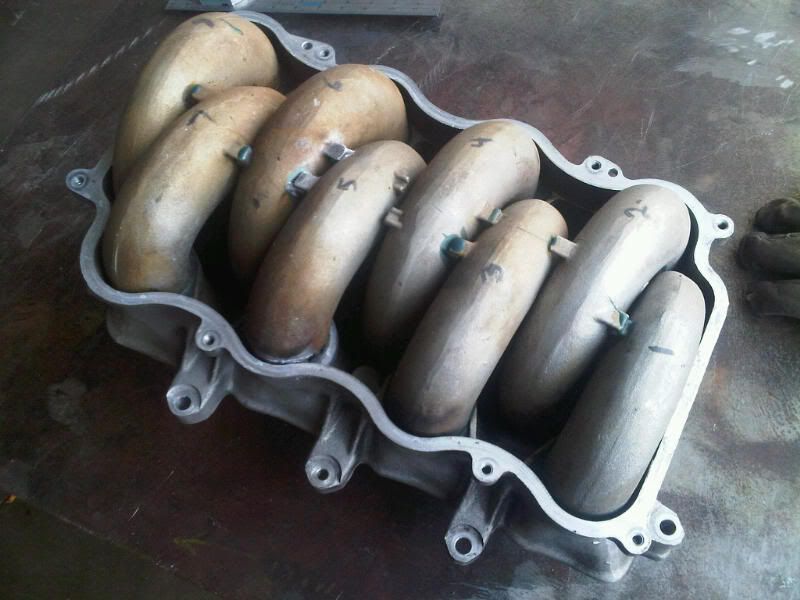
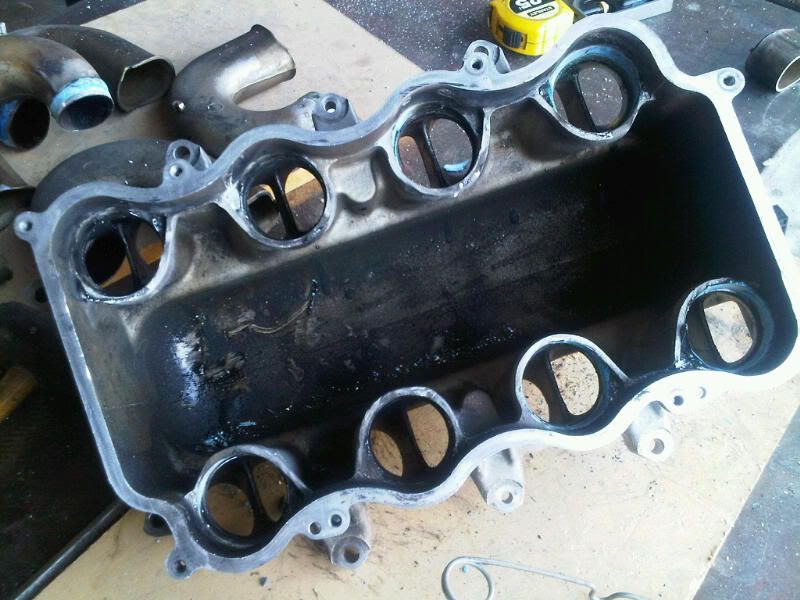
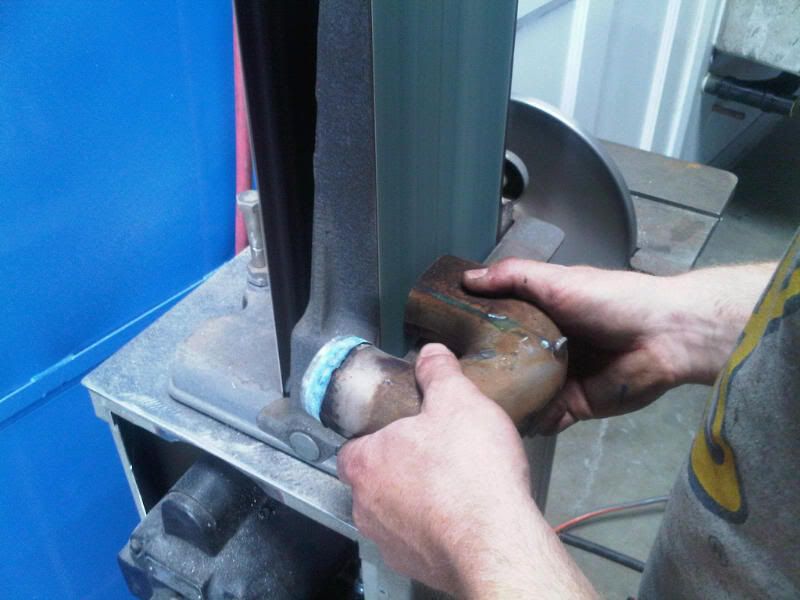

Posted by Luke87GT (Member # 21) on
:
UPDATE - 12/5/10
Today I finally managed to wrap up the short runner intake. It was quite an involved project and I would like to thank bitemark46 (Mark) & NA SVT (Todd) from svtperformance for putting up with all my questions and providing me with helpful advice.
In the end I cut 1 1/2 - 1 5/8" off each runner, profiled the runner bosses, applied epoxy ledge fillers, and cleaned up the casting flash. I used about three 10oz packages of JB Weld Industo which amounted to about $50 in epoxy alone.
:salute:
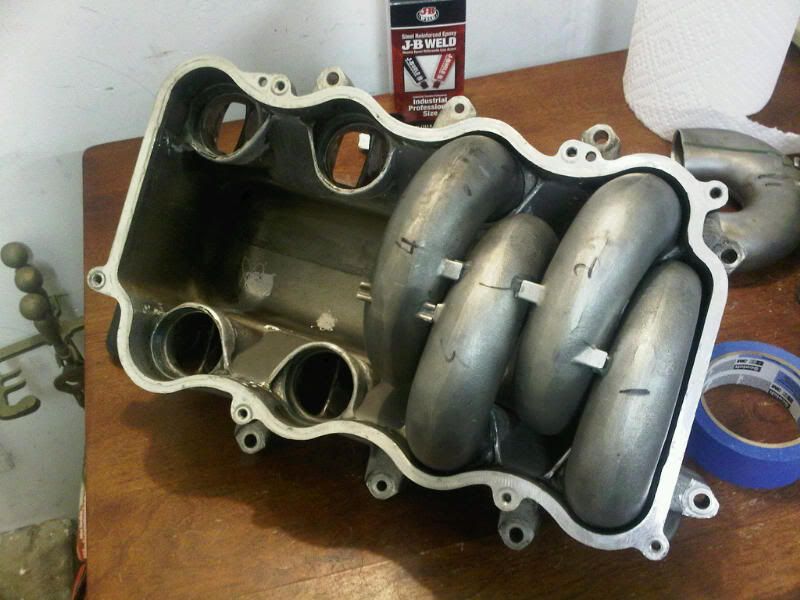
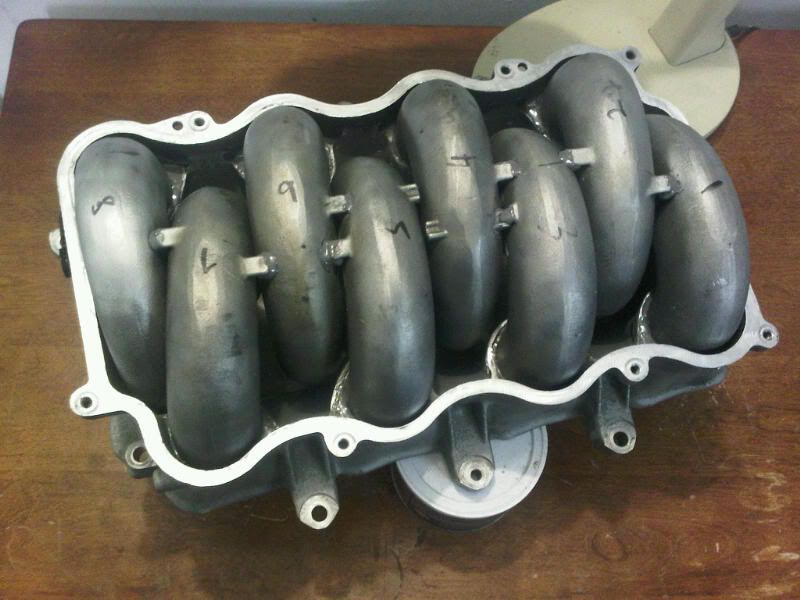
UPDATE - 2/13/11
Hey folks,
This update is certainly over-due. On Saturday morning I finally managed to install the short runner intake that I built over the past few months along with the IMRC deletes.
The install was fairly straight forward but as usual it took much longer than expected since I was doing this for the first time on a 4.6L DOHC. In addition to this, I discovered broken pintle caps on two of the injectors which required a trip to the autoparts store.
This was also my first experience with the infamous coolant cross-over tube. I spent quite a bit of time trying to get it out without damaging it. It required a large screwdriver acting as a prybar to finally let go. I had to drain the coolant just enough to get the level below the cross-over tube.
The most inconvenient part was probably the fuel system. Some guys remove the rails which makes it easier, but I decided to just swing them out of the way... And it seemed like those were constantly coming back into the picture and getting in the way!
Additionally, re-usable gaskets are a major WIN on these 96-up Mustangs! No scraping and no mess. Simply wipe off and re-use. Gasket technology has come a LONG way.
As far as driving impressions, I've put approximately 50 miles on it and it has not yet thrown a code despite the IMRC motor not being connected. This is puzzling as I expected the CEL to come on right away.
Although my butt-meter is not very accurate, the car does feel noticeably more sluggish between idle-3000RPM, but feels stronger between 4500-7000RPM. The loss below 3000RPM is not that dramatic and the 4.30s mask it adequately.
The old IMRCs were not terribly gunked up either. This is probably because they were cleaned 25K miles ago at the time that the heads were rebuilt on this car.
The next step will be to get the car tuned. Because it is cost effective, I am leaning towards starting off with a mail order tune (based on data-logs that I provide to the tuner). I also expect more than 1 iteration of the tune in order to dial in the A/F and give it as much SPARK ADVANCE as it can handle on 91 octane. This process will also allow me to actively be part of the process and see what is being manipulated by comparing data-logs. If I am not pleased with the results, then I can have the car dyno tuned locally.
Lastly, I need to purchase a Wide-Band this week. I'm leaning towards the Innovate Motorsports LC-1, shown in the link below:
LC-1 Lambda Cable with 02 Sensor : Wideband Controller Cable for Dyno, ECU, Data Acquisition, or Gauge Applications
This one also looks interesting and it is priced comparably (comes with gauge):
MTX-L Wideband O2 Digital Air/fuel Ratio Gauge
I'm wondering if anyone has any recommendations on this?

Posted by MauriSSio (Member # 9943) on
:
i like the AEM wideband set up.
Posted by MauriSSio (Member # 9943) on
:
as far as your 12:1AFR ratio thats pretty good compared to what most OEMs run without tuning.
also, Are you looking to set up the wideband permanently or just need one for tuning?
Posted by Luke87GT (Member # 21) on
:
quote:
Originally posted by MauriSSio:
as far as your 12:1AFR ratio thats pretty good compared to what most OEMs run without tuning.
also, Are you looking to set up the wideband permanently or just need one for tuning?
Just for tuning.
The 12:1 is a tailpipe measurement so it is showing leaner than it really is. The commanded A/F ratio is 0.75 Lambda (0.75 x 14.68 = 11.0 A/F at the header)
I'll take a look at the AEM WB
Posted by Blind (Member # 3052) on
:
Luke,
Go for the innovate wideband, for 2 key reasons that other widebands can't compete with -
1 - Fully Digital
2 - O2 sensors can be calibrated, and it has a detection for a bad sensor, other brands when the o2 sensor fails will just read wrong!
I run the innovate G2 gauge in my harley truck as it matches the stock dash -
http://www.innovatemotorsports.com/products/g2_gauge.php
I ordered it from Summit, but had them price match to this place over the phone -
http://vr-speed.com/store/innovate-motorsports-gauge-gauge-sensor-p-499.html
I think the MTX-L setup would look best in your car though -
http://www.innovatemotorsports.com/products/MTXL.php
[ February 14, 2011, 12:45 PM: Message edited by: Blind ]
Posted by MauriSSio (Member # 9943) on
:
quote:
Originally posted by Luke87GT:
quote:
Originally posted by MauriSSio:
as far as your 12:1AFR ratio thats pretty good compared to what most OEMs run without tuning.
also, Are you looking to set up the wideband permanently or just need one for tuning?
Just for tuning.
The 12:1 is a tailpipe measurement so it is showing leaner than it really is. The commanded A/F ratio is 0.75 Lambda (0.75 x 14.68 = 11.0 A/F at the header)
I'll take a look at the AEM WB
well im in san jose. if you aint gonna use it for too long, and If you got the money i can let you borrow mine and then give you your cash back when youre done with it this way you dont have to buy one just to tune it.
Posted by Luke87GT (Member # 21) on
:
Blind, thanks for the reply. I am leaning towards the Innovate MTX-L. Even though I don't plan on having it on permanently, it has a digital readout plus an analog output for my data-logger and is only a few bucks pricier than the LC-1.
Maurissio, thank you for the offer. Since I don't know how long I will need it, I probably should own one myself.
Posted by MauriSSio (Member # 9943) on
:
quote:
Originally posted by Luke87GT:
Blind, thanks for the reply. I am leaning towards the Innovate MTX-L. Even though I don't plan on having it on permanently, it has a digital readout plus an analog output for my data-logger and is only a few bucks pricier than the LC-1.
Maurissio, thank you for the offer. Since I don't know how long I will need it, I probably should own one myself.
no problem. If you change your mind let me know. My friend is buying a carb this week and after im done using the wideband on it, i dont forsee using it much after that so youd probably be able to borrow it for weeks at a time. anyways, if you change your mind let me know
Posted by Luke87GT (Member # 21) on
:
quote:
Originally posted by MauriSSio:
quote:
Originally posted by Luke87GT:
Blind, thanks for the reply. I am leaning towards the Innovate MTX-L. Even though I don't plan on having it on permanently, it has a digital readout plus an analog output for my data-logger and is only a few bucks pricier than the LC-1.
Maurissio, thank you for the offer. Since I don't know how long I will need it, I probably should own one myself.
no problem. If you change your mind let me know. My friend is buying a carb this week and after im done using the wideband on it, i dont forsee using it much after that so youd probably be able to borrow it for weeks at a time. anyways, if you change your mind let me know
Thank you sir, I appreciate that.
Posted by Luke87GT (Member # 21) on
:
Hey folks, been a good while, but was able to put a bit of time into wiring up the Innovate MTX-L and syncing it up to Livelink/Xcal2 tuner.
The inside of my car looks like a science experiment with all the wiring/electronics everywhere.
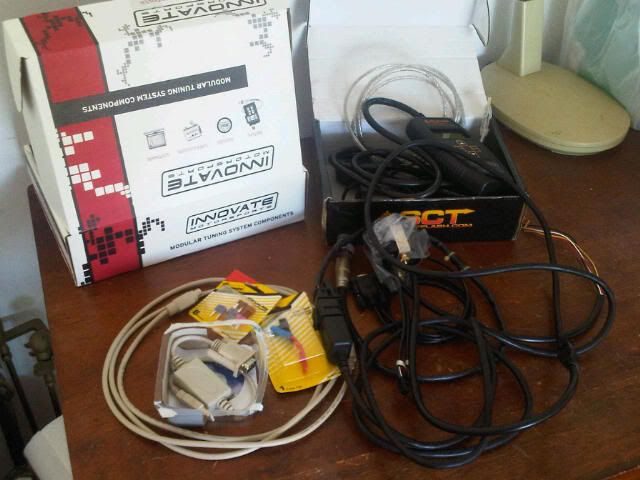
Posted by Luke87GT (Member # 21) on
:
Just to wrap this up ![[patriot]](graemlins/patriot.gif)
Hi folks,
After all the modifications and tuning, I had a chance to hit the dyno.
With the A/F ratio dialed in (12.5-13.0 : 1), I was able to strap the car down to the rollers and play with different spark advance settings using my handheld.
When the day was over, the car liked 30.5* of timing with the 91 octane, and layed down 304.8rwhp STD / 297.2rwhp SAE
The dyno operator's wideband was pretty much spot on with the wideband I was using from Innovate.
Here are the plots for both STD and SAE correction factors:
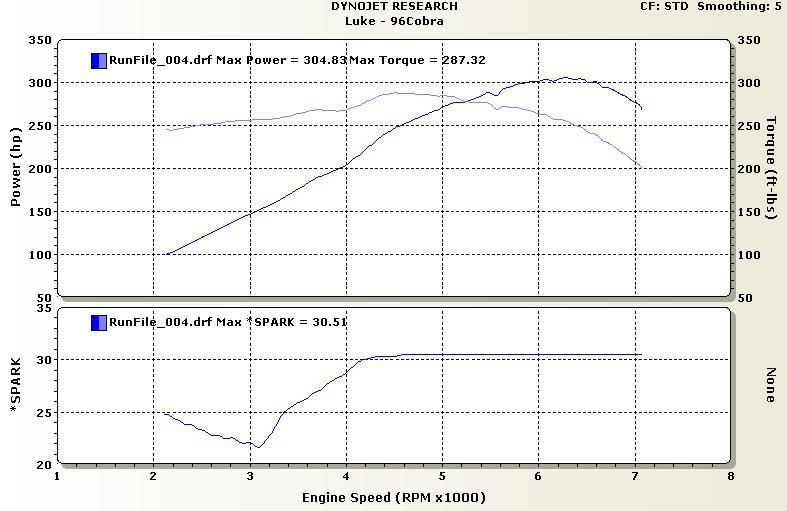
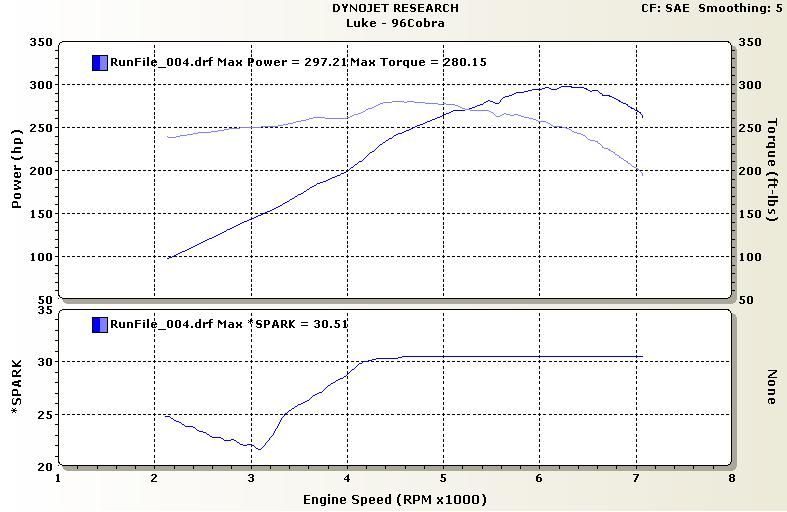
Also, just as a comparison, I overlayed the power plot when the car was stock compared to the power plot with the following modifications:
- JLT RAI
- March Fluidamper + Water Pump Pulley
- IMRC Deletes
- Short Runner Intake
- 2.5" H-pipe
- 2.5" Cat-back
- Aluminum Driveshaft
- Tune
(note that before the tune, the car had some timing glitches that results in power spikes, this has been taken care of in the tune)
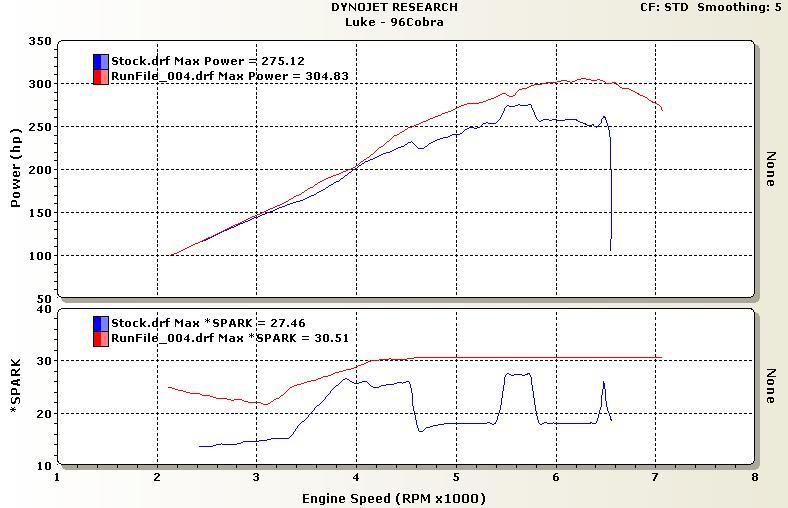
When the car was stock, the power peaked at about 6K RPM (when the timing wasn't jumping around). With the modifications, largely attributed to the short runner, the peak now occurs around 6280RPM, as expected.
Not only does the peak power go up by about ~30rwhp, the tail carries much longer... and thanks to the tune, I did not lose power anywhere at low RPM despite the IMRC deletes and short-runner intake.
Discussing this with the dyno operator, there are several items that would increase HP further. First, us CA guys are limited to 91 octane which limits how much timing you can add without ping. Next, I did the dyno pull with heavy 18x10 chrome Saleens with 295-35-18 tires. According to the tech, if I had used a stock 17x8 245mm combo, it would have netted several rwhp as well. Also, numerically steeper gears will result in lower HP readings (I am using a 4.30 gear). And finally, longtubes. Again, I can't pass smog with them in CA so I avoided adding them and instead stayed with the stock exhaust manifolds.
All in all it has been a successful project and I learned a lot about tuning, SCT SW, Innovate HW, etc. I'd like to thank everyone for their help.
Luke
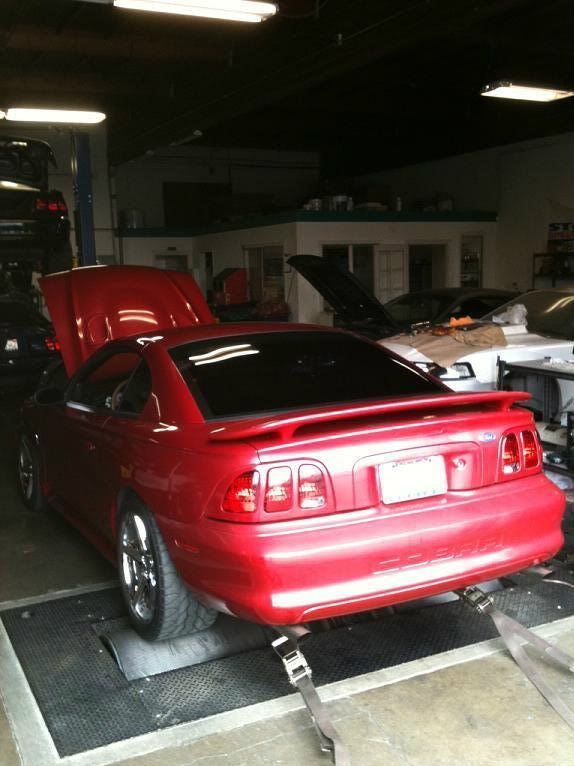
http://www.youtube.com/watch?v=nY4gON-C45w
http://www.youtube.com/watch?v=MsISAx2_OAU
More details can be seen here:
http://www.svtperformance.com/forums/sn95-cobras-24/689723-project-1996-cobra.html
[ September 15, 2011, 12:14 PM: Message edited by: Luke87GT ]
Posted by Blind (Member # 3052) on
:
great numbers, but what's it do at the track? ![[Smile]](smile.gif)
Posted by Luke87GT (Member # 21) on
:
quote:
Originally posted by Blind:
great numbers, but what's it do at the track? ![[Smile]](smile.gif)
Hopefully I can get it into the 14s with cool weather and a tailwind ![[Wink]](wink.gif)
And what does yours do at the track?
[ September 15, 2011, 12:36 PM: Message edited by: Luke87GT ]
Posted by Blind (Member # 3052) on
:
quote:
Originally posted by Luke87GT:
quote:
Originally posted by Blind:
great numbers, but what's it do at the track? ![[Smile]](smile.gif)
Hopefully I can get it into the 14s with cool weather and a tailwind ![[Wink]](wink.gif)
And what does yours do at the track?
14s? that sounds fast!
I dunno about straight line, but it busts out the streets of willow in 1:26 laps. I don't really have an easily accessible 1/4 mile near me, last time I went to a test `n tune with my `89 down here I wasted 5 hours and got 3 runs in, so pointless.
Posted by turbo50 (Member # 6700) on
:
Time for a coyote crate motor!!
Fueled by Ford Mustang Owners
on CaliforniaFords.com
![[patriot]](graemlins/patriot.gif)





![[patriot]](graemlins/patriot.gif)



![[patriot]](graemlins/patriot.gif)
![[patriot]](graemlins/patriot.gif)
![[Smile]](smile.gif)
![[worship]](graemlins/worship.gif)
![[Wink]](wink.gif)
![[patriot]](graemlins/patriot.gif)
![[patriot]](graemlins/patriot.gif)
![[patriot]](graemlins/patriot.gif)
![[burnout]](graemlins/burnout.gif)
![[Confused]](confused.gif)
![[Confused]](confused.gif)
![[Confused]](confused.gif)
![[Big Grin]](biggrin.gif)
![[patriot]](graemlins/patriot.gif)


![[Confused]](confused.gif)
![[dance]](graemlins/dance.gif)
![[Confused]](confused.gif)
![[dance]](graemlins/dance.gif)
![[Confused]](confused.gif)
![[Big Grin]](biggrin.gif)








![[patriot]](graemlins/patriot.gif)




![[Smile]](smile.gif)
![[Smile]](smile.gif)
![[Wink]](wink.gif)
![[Smile]](smile.gif)
![[Wink]](wink.gif)